ByJordyn Holman and Julie Creswell
May 28, 2023 —
For years in the US, Pride Month, the annual celebration for LGBTQ Americans in June, has afforded companies a marketing opportunity to tap into the buying power of a group with growing financial, political and social clout.
Yet, while these efforts have always faced some opposition, brands and marketers say the country’s current political environment – especially around transgender issues – has made this year’s campaigns more complicated. Last week, Target became the latest company to rethink its approach after facing criticism for its Pride collection, which included clothes and books for children that drew outrage from some on the right.
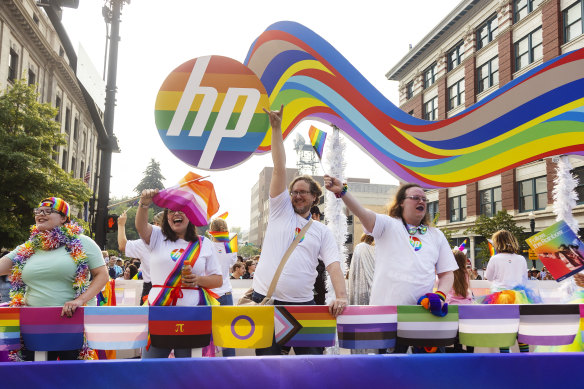
Companies have long embraced Pride month as a marketing opportunity.
CREDIT:IDOHO STATESMAN
The retailer moved its Pride displays – including rainbow-striped collared shirts, yellow hoodies reading “Not a Phase” and baby clothing and accessories – from the entrances of some Target stores around the country and placed them in the back.
Target said it was concerned “about threats impacting our team members’ sense of safety and well-being while at work” after some customers had screamed at employees and thrown the Pride-themed merchandise on the floor.
Among the items angering some customers was a one-piece bathing suit that has extra material for the crotch area for individuals who want to conceal their genitalia. Some critics erroneously claimed that the swimsuit was being sold to children; Target said it was available only in adult sizes. The collection also includes children’s books about transgender issues and gender fluidity.
One woman recorded a TikTok video in a Target store last Monday in which she became angry at seeing a greeting card that read “So Glad You Came Out” and a yellow onesie that said “¡Bien Proud!”
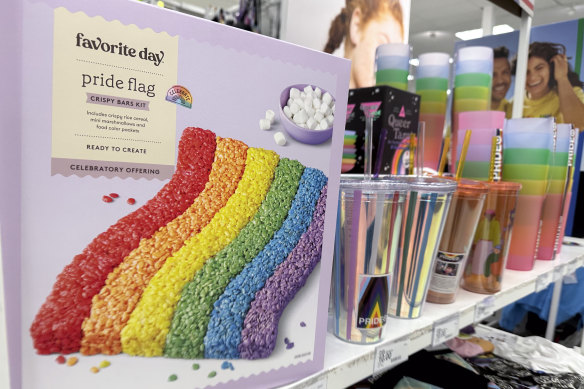
Pride month merchandise at Target. The retailer is removing certain items from sale.
The retailer moved its Pride displays – including rainbow-striped collared shirts, yellow hoodies reading “Not a Phase” and baby clothing and accessories – from the entrances of some Target stores around the country and placed them in the back.
Target said it was concerned “about threats impacting our team members’ sense of safety and well-being while at work” after some customers had screamed at employees and thrown the Pride-themed merchandise on the floor.
Among the items angering some customers was a one-piece bathing suit that has extra material for the crotch area for individuals who want to conceal their genitalia. Some critics erroneously claimed that the swimsuit was being sold to children; Target said it was available only in adult sizes. The collection also includes children’s books about transgender issues and gender fluidity.
One woman recorded a TikTok video in a Target store last Monday in which she became angry at seeing a greeting card that read “So Glad You Came Out” and a yellow onesie that said “¡Bien Proud!”

Pride month merchandise at Target. The retailer is removing certain items from sale.
CREDIT:AP
“If that doesn’t give you a reason to boycott Target, I don’t know what does,” she said.
In a statement, a company spokesperson said, “Given these volatile circumstances, we are making adjustments to our plans, including removing items that have been at the centre of the most significant confrontational behaviour.” She added that the company, which has been selling Pride Month merchandise for a decade, remained committed to the LGBTQ community “and standing with them as we celebrate Pride Month and throughout the year”.
While Target said its decision had been made in the interest of employee safety, many said its actions – along with a conservative backlash against Bud Light after it worked with a transgender influencer – might alienate the community it was seeking to support. And those who criticised Target and Bud Light in the first place may now feel further emboldened to attack inclusive initiatives by other companies.
“We’re in a new space here with safety and employee safety being threatened by policy and purpose,” said Vanitha Swaminathan, professor of marketing at the University of Pittsburgh. “I can’t say that you can disregard employee safety. That’s very core to what a company has to do. At the same time, Target can still, from a policy standpoint, be supportive of their initial stance. It’s sad to see that we’ve reached this point in our culture wars.”
“If that doesn’t give you a reason to boycott Target, I don’t know what does,” she said.
In a statement, a company spokesperson said, “Given these volatile circumstances, we are making adjustments to our plans, including removing items that have been at the centre of the most significant confrontational behaviour.” She added that the company, which has been selling Pride Month merchandise for a decade, remained committed to the LGBTQ community “and standing with them as we celebrate Pride Month and throughout the year”.
While Target said its decision had been made in the interest of employee safety, many said its actions – along with a conservative backlash against Bud Light after it worked with a transgender influencer – might alienate the community it was seeking to support. And those who criticised Target and Bud Light in the first place may now feel further emboldened to attack inclusive initiatives by other companies.
“We’re in a new space here with safety and employee safety being threatened by policy and purpose,” said Vanitha Swaminathan, professor of marketing at the University of Pittsburgh. “I can’t say that you can disregard employee safety. That’s very core to what a company has to do. At the same time, Target can still, from a policy standpoint, be supportive of their initial stance. It’s sad to see that we’ve reached this point in our culture wars.”
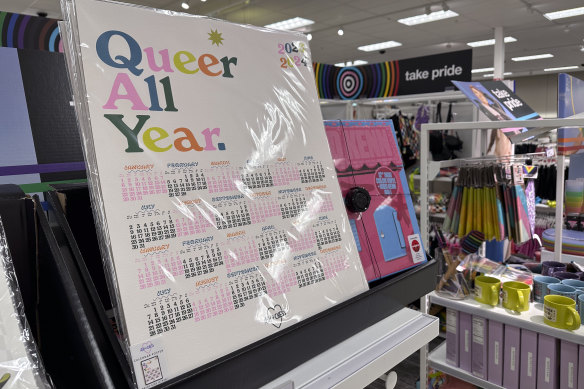
Employee safety is prompting the removal of some Pride items from Target shelves.
CREDIT:AP
Marketing campaigns around Pride Month in June have become routine for many companies, with opposition cropping up at times. Last year, for instance, Pizza Hut faced calls for a boycott after it recommended Big Wig, a book featuring drag performers, as part of its children’s summer reading program.
Yet companies and marketers say the political climate makes this year different – primarily because a number of Republican-led states have introduced and passed legislation restricting transition care for transgender minors and adults, and transgender rights has become a galvanising issue for many conservative
GLAAD, the LGBTQ advocacy group that works with more than 160 companies, is considering having communications professionals in its GLAAD Media Institute work with brands that are planning Pride Month celebrations so they can better respond to criticism.
“We do feel like we’re at a moment where, with the politicisation of trans and gender-nonconforming folks, that we probably need to assemble a Pride war room for brands so that we can push back,” Sarah Kate Ellis, the group’s chief executive, said in an interview.
Marketing campaigns around Pride Month in June have become routine for many companies, with opposition cropping up at times. Last year, for instance, Pizza Hut faced calls for a boycott after it recommended Big Wig, a book featuring drag performers, as part of its children’s summer reading program.
Yet companies and marketers say the political climate makes this year different – primarily because a number of Republican-led states have introduced and passed legislation restricting transition care for transgender minors and adults, and transgender rights has become a galvanising issue for many conservative
GLAAD, the LGBTQ advocacy group that works with more than 160 companies, is considering having communications professionals in its GLAAD Media Institute work with brands that are planning Pride Month celebrations so they can better respond to criticism.
“We do feel like we’re at a moment where, with the politicisation of trans and gender-nonconforming folks, that we probably need to assemble a Pride war room for brands so that we can push back,” Sarah Kate Ellis, the group’s chief executive, said in an interview.
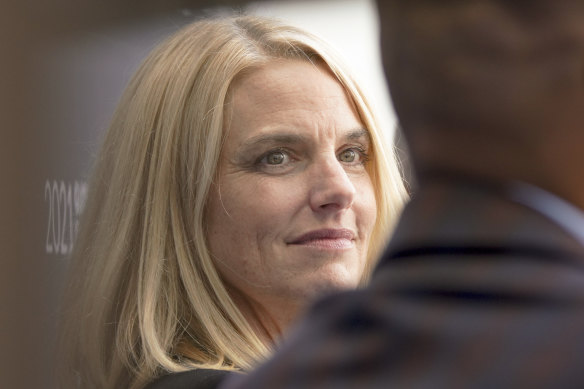
Sarah Kate Ellis, president and chief executive officer of GLAAD.
CREDIT:BLOOMBERG
On Thursday, GLAAD and six other advocacy groups called on Target to return to its stores and its website any Pride merchandise it had removed and to release a statement “in the next 24 hours reaffirming their commitment” to the LGBTQ community.
When faced with criticism and social media calls for boycotts in the past, most companies learned that the declarations of outrage soon faded away.
Then Bud Light happened. Owned by the beer giant Anheuser-Busch, Bud Light continues to struggle with the fallout from a social media campaign in mid-March with transgender influencer Dylan Mulvaney. After calls for a boycott of the beer, sales in the four weeks ending in mid-May dropped more than 23 per cent from a year earlier, according to data from the research firm NIQ and Bump Williams Consulting, which works with the alcoholic beverage industry.
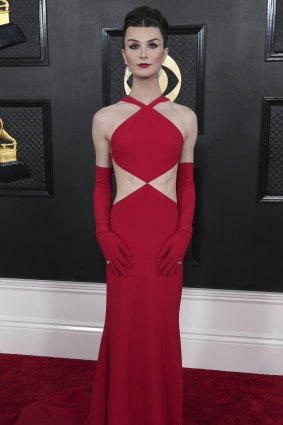
Bud Light sales have not recovered from the backlash to a social media campaign with Dylan Mulvaney.
In some markets in the South, such as Jacksonville, Florida, and New Orleans, Bud Light’s sales were down 40 per cent in those four weeks.
Anheuser-Busch, which in recent years has released rainbow-hued bottles and cans of Bud Light for Pride Month, did not respond to a question about its plans for this year.
Some marketing and communications consultants said the negative reaction to Bud Light’s campaign with Mulvaney was a product of the beer’s generally more politically conservative customer base. Companies like Nike or Starbucks can more easily create products or campaigns around gay and transgender issues or Pride Month because their consumers tend to be younger and more progressive, said David Johnson, chief executive of Strategic Vision PR Group in Atlanta. “When they embrace the gay or transgender community, it’s not out of line with their core beliefs,” he said.
A number of companies are moving forward with their Pride Month plans. In June, the Coors Light Denver Pride Parade will weave its way through the city. Advertisements for a one-piece Adidas swimsuit created by South African queer designer Rich Mnisi feature a transgender man as the model. Levi’s has a campaign showing a half-dozen gay and transgender people talking about how they show up while wearing the company’s denim and tops.
But a number of other companies are being much less forthcoming about specific Pride Month plans. And some LGBTQ advocates criticised Target for seeming to cave to pressure. (The company’s decision did come as employees in the retail industry have faced increasingly aggressive behaviour from customers since the start of the pandemic.)
Target also removed a Pride line from Abprallen, an LGBTQ fashion and accessories company based in London, some of whose designs have been criticised for depicting satanic symbols like pentagrams and a shirt that reads “Satan respects pronouns”. Abprallen did not respond to a request for comment.
“We’ll find out in the next week which companies are continuing to make a push and do Pride Month campaigns,” said Matt Skallerud, the president of Pink Media, which specialises in LGBTQ online marketing. “If companies we know have been supportive of Pride Month don’t show up this year, their absence will be noticed, and I’d be concerned that could harm them.”
Advocacy groups are wary that all of this could create a chilling effect, especially when it comes to attaining a broader representation of LGBTQ people in advertising.
“White gay men are the one segment that are most likely represented on our screens, whether it’s programing or ads,” said Lisette Arsuaga, co-founder of the Alliance for Inclusive and Multicultural Marketing. “We now started moving forward with a greater representation of all of the letters within the LGBTQ.”
The overall consumer sentiment for seeing trans representation on TV and in advertising hasn’t changed, according to recent GLAAD research. In a survey that was conducted in February, GLAAD said 75 per cent of people who did not identify as LGBTQ were comfortable seeing those people represented in marketing campaigns.
On Thursday, GLAAD and six other advocacy groups called on Target to return to its stores and its website any Pride merchandise it had removed and to release a statement “in the next 24 hours reaffirming their commitment” to the LGBTQ community.
When faced with criticism and social media calls for boycotts in the past, most companies learned that the declarations of outrage soon faded away.
Then Bud Light happened. Owned by the beer giant Anheuser-Busch, Bud Light continues to struggle with the fallout from a social media campaign in mid-March with transgender influencer Dylan Mulvaney. After calls for a boycott of the beer, sales in the four weeks ending in mid-May dropped more than 23 per cent from a year earlier, according to data from the research firm NIQ and Bump Williams Consulting, which works with the alcoholic beverage industry.

Bud Light sales have not recovered from the backlash to a social media campaign with Dylan Mulvaney.
In some markets in the South, such as Jacksonville, Florida, and New Orleans, Bud Light’s sales were down 40 per cent in those four weeks.
Anheuser-Busch, which in recent years has released rainbow-hued bottles and cans of Bud Light for Pride Month, did not respond to a question about its plans for this year.
Some marketing and communications consultants said the negative reaction to Bud Light’s campaign with Mulvaney was a product of the beer’s generally more politically conservative customer base. Companies like Nike or Starbucks can more easily create products or campaigns around gay and transgender issues or Pride Month because their consumers tend to be younger and more progressive, said David Johnson, chief executive of Strategic Vision PR Group in Atlanta. “When they embrace the gay or transgender community, it’s not out of line with their core beliefs,” he said.
A number of companies are moving forward with their Pride Month plans. In June, the Coors Light Denver Pride Parade will weave its way through the city. Advertisements for a one-piece Adidas swimsuit created by South African queer designer Rich Mnisi feature a transgender man as the model. Levi’s has a campaign showing a half-dozen gay and transgender people talking about how they show up while wearing the company’s denim and tops.
But a number of other companies are being much less forthcoming about specific Pride Month plans. And some LGBTQ advocates criticised Target for seeming to cave to pressure. (The company’s decision did come as employees in the retail industry have faced increasingly aggressive behaviour from customers since the start of the pandemic.)
Target also removed a Pride line from Abprallen, an LGBTQ fashion and accessories company based in London, some of whose designs have been criticised for depicting satanic symbols like pentagrams and a shirt that reads “Satan respects pronouns”. Abprallen did not respond to a request for comment.
“We’ll find out in the next week which companies are continuing to make a push and do Pride Month campaigns,” said Matt Skallerud, the president of Pink Media, which specialises in LGBTQ online marketing. “If companies we know have been supportive of Pride Month don’t show up this year, their absence will be noticed, and I’d be concerned that could harm them.”
Advocacy groups are wary that all of this could create a chilling effect, especially when it comes to attaining a broader representation of LGBTQ people in advertising.
“White gay men are the one segment that are most likely represented on our screens, whether it’s programing or ads,” said Lisette Arsuaga, co-founder of the Alliance for Inclusive and Multicultural Marketing. “We now started moving forward with a greater representation of all of the letters within the LGBTQ.”
The overall consumer sentiment for seeing trans representation on TV and in advertising hasn’t changed, according to recent GLAAD research. In a survey that was conducted in February, GLAAD said 75 per cent of people who did not identify as LGBTQ were comfortable seeing those people represented in marketing campaigns.
That figure held steady from 2020.
“You can absolutely roll out an ad campaign and include LGBTQ folks in it,” Ellis of GLAAD said. “And at the same time, there is this political right-wing arm that you have to be aware of when you’re doing it and just be prepared for.”
This article originally appeared in The New York Times.

No comments:
Post a Comment